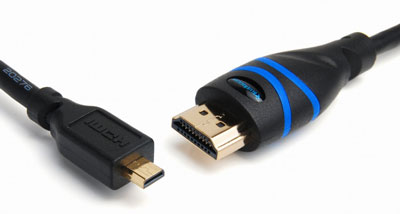Whether you’re sharing photos from a recent trip or traveling down memory lane, it’s hard to do your pictures justice on your smartphone or camera’s small screen. So why not take advantage of the big screen you already have—your TV?
It’s easy and you probably already have everything you need. Check out the following options to start viewing your pictures and videos on your TV.
1. Use your smart TV or streaming media player’s Internet apps.
If you have a smart TV with Internet apps, you can use a photo viewing app on your TV to access images you’ve stored on the web. Select the app center on your TV—i.e. Samsung Smart Hub, Vizio Internet Apps, Panasonic Viera Connect or LG Smart TV to name a few. Each manufacturer has a unique name for its service. Streaming media players, like Roku, also have apps that let you view photos stored on the web.
Once you’re in the app section, select a photo sharing service app, like Picasa or Flickr. After logging in, you can choose to view your photos—individually or in a slideshow—or photos that others are sharing across the web.
For videos, you can use YouTube. Don’t want strangers viewing your videos? You can always choose to make them private when you upload them.
2. Connect your smartphone via HDMI.

If you purchased a high-end Android phone within the last two years, like the Samsung Galaxy S 4, HTC One Max or LG 2, your phone may have a micro HDMI out port. In that case, seeing your photos is a simple matter of connecting your phone to your TV with a micro-HDMI-to-HDMI cable. For a basic cable, we like the one from BlueRigger ($6.99 on Amazon). For phones that support MHL (a variation of HDMI that allows your phone to draw power and send video simultaneously), we like the one from Skiva ($7.99 on Amazon). Check with your phone manufacturer to see if your smartphone supports micro HDMI or HDMI MHL.
3. Connect your smartphone or tablet wirelessly.
If you purchased a TV or video game console (i.e. Xbox 360, Xbox One, PlayStation 3 or PlayStation 4) and a smartphone within the last few years, they most likely have a wireless technology called DLNA (you can check for your model on dlna.org).
If your smartphone and TV are made by the same manufacturer, there’s likely a setting called screen mirroring (or something similar) on both devices. This will enable you to see whatever is on your smartphone on your TV. If your devices are made by different manufacturers, you’ll need to enable DLNA (also sometimes called Wi-Fi Direct) on your TV and load a DLNA app on your smartphone. We like iMediaShare Personal (free for iOS and Android).
For those that have an Apple TV and iPhone or iPad, you can use the AirPlay feature to share your photos and pictures with your TV. Or, if you have a Roku box, Chromecast (YouTube videos only) or another streaming media player, you can load that player’s app on your smartphone or tablet for sharing.
4. Use your phone or camera’s memory card.

Pop the memory card out of your camera or smartphone and put it into the TV’s SD card reader. Most flat panel TVs have an SD card reader. If you’re not sure whether yours does, your owner’s manual will tell you. For phones, you’ll need a microSD-to-SD card adapter, like the one from SanDisk ($3.49 on Amazon). For most TVs, inserting an SD card will launch the photo viewer.
5. Use a USB cable or flash drive.
Take the USB cable that came with your camera and use it to connect the camera to your TV’s USB port. Again, most flat panel TVs made over the last few years have a USB port. If your photos and videos are stored on your computer, you can copy them onto a USB flash drive and then insert the drive into your TV’s USB port. On most TVs, inserting the USB cable or flash drive will automatically launch the TV’s photo viewing app. From there, you can choose to view photos, videos or a combination of both. Manually scroll through or set your photos to music for a slideshow.
As you can see, there’s no reason to make everyone crowd around a tiny display when it’s so easy to share pictures on your big-screen TV.
This article was written by Suzanne Kantra and originally appeared on Techlicious.
More from Techlicious:
More Must-Reads from TIME
- Donald Trump Is TIME's 2024 Person of the Year
- Why We Chose Trump as Person of the Year
- Is Intermittent Fasting Good or Bad for You?
- The 100 Must-Read Books of 2024
- The 20 Best Christmas TV Episodes
- Column: If Optimism Feels Ridiculous Now, Try Hope
- The Future of Climate Action Is Trade Policy
- Merle Bombardieri Is Helping People Make the Baby Decision
Contact us at letters@time.com